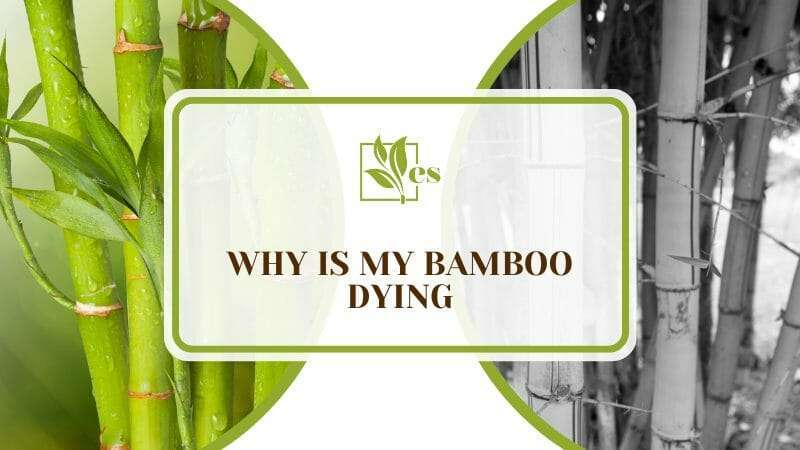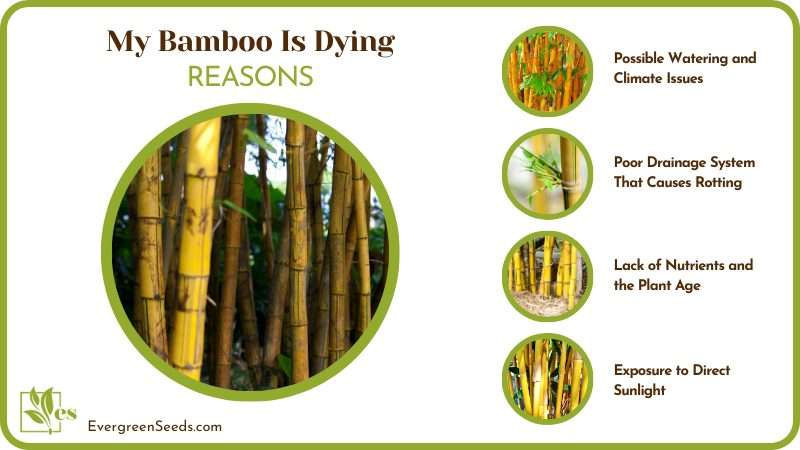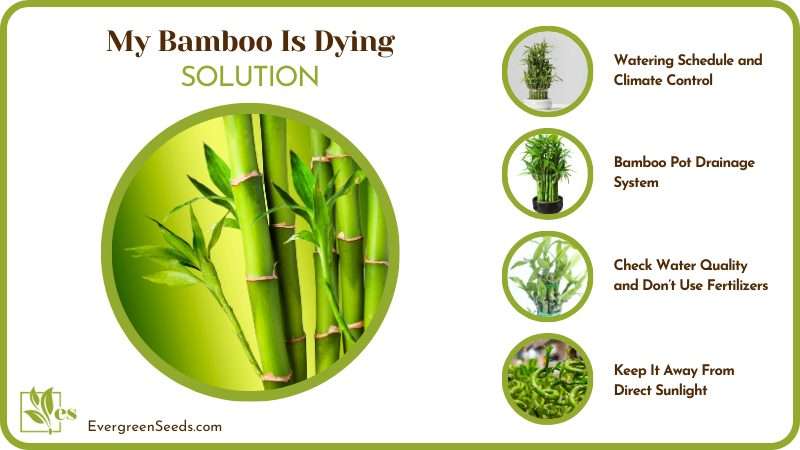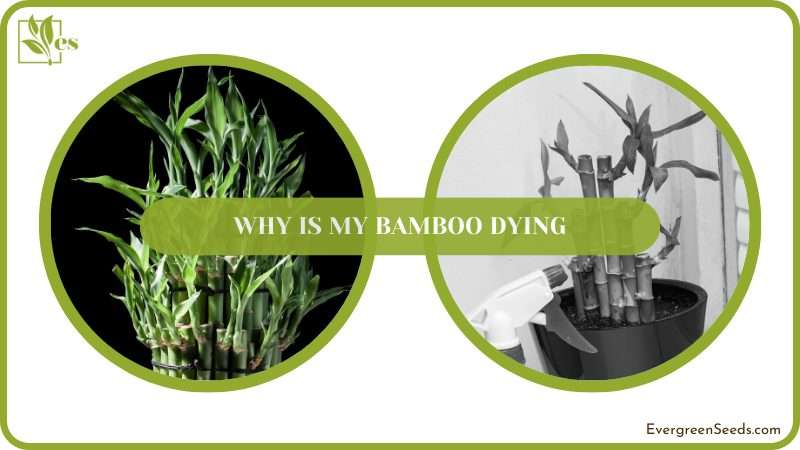Why is my bamboo dying? If you are wondering this, you probably have lots of love for the Asian plant. These evergreen plants of the Poaceae family are fast and easy to grow.

Thus, most of the time, they die because of overwatering or underwatering. The same thing might happen to plants that look like bamboo too! However, there are other possible reasons which you can find out by reading on.
JUMP TO TOPIC
What Is the Most Common Reason Why My Bamboo Is Dying?
The most common reason for dying bamboo is the climate. However, it can also be affected by water drainage, the soil, watering, and sunlight. Each of these can significantly influence the state of the plant and cause even more harm to it, leading to a chain effect, which ends up with dying bamboo.
Bamboos are among the most easily fast-growing evergreens we know. They are plants native to Asia and are beloved by many due to their qualities and are not easy to kill. On the contrary, the lucky bamboo plant is a vigorous plant prone to grow tall and firm without any issues. That, however, goes as far as in its natural climate and conditions.
When determining the cause, it is crucial not to make conclusions hastily about why your bamboo is in a bad state. For example, is it due to watering issues, or is the temperature too cold?
Most often, you will mistake the cause without enough information and harm the plant even further. Therefore, observing the plant is the best way to tell whether bamboo is dying and why.
– Possible Watering and Climate Issues
Bamboo, like every other plant, needs water. In cases where you grow them at home, you will have to take care of their watering correctly. That means you should know how often to water them, how much to pour and when to do it.
While watering this plant, you have to consider the following:
- Your location, climate, and even timezone – is it hot or cold during most of the day? Is it too sunny?
- How many lucky bamboos have you planted, and are they planted densely next to each other;
- What is the current season, and how often does it rain?
These factors are essential when looking at what makes the lucky bamboo die. For example, if you live in a dry, hot climate, the problem is possible with the watering schedule for the bamboo plant. However, if you live in drier weather where the soil is colder and there is no direct sunlight, the problem can be with the temperature.
All of this is strictly based on how much water and sunlight the plant requires. Unfortunately, many people do not pay attention to these details and tend to overwater their plants or plant them out in the open.
They do not consider how much water soil can take. How fast it will evaporate due to the weather conditions. Thus this is one of the most common reasons why plants die.

– Poor Drainage System That Causes Rotting
Why is the drainage system a possible major issue? This is because too much water in the soil around the bamboo can cause overwatering. From there, the roots of the plant will rot. The body of the lucky bamboo can get infected by a parasite, and eventually, the plant will die.
The drainage system issues go for the potted bamboo and the one out in your garden. Those of you who grow bamboo in big pots, trying to prepare them for the backyard, do not pay attention to the container.
These pots occasionally come without holes. If you do not look at it before you fill it with soil, you will probably never find out. In such cases, the water will not be able to drain out, and from there, it will ruin the roots of the bamboo, causing overwatering, rotting, or pest infection.
– Lack of Nutrients and the Plant Age
Bamboos are lovely and fast-growing. The green color is probably the most calming yet never changing. Sometimes the leaves can turn from a beautiful green to a yellowish color.
This change often is nothing serious to worry about. However, in rare cases, it can signal something is wrong with the tree, especially if the bamboo turn yellow too. Because of that, you must observe what the leaves look like, as there are slight differences.
For example, the most common reason for yellow leaves is the plant cutting off nutrients from the older leaves. As you know, trees live thanks to their leaves. However, these leaves also have a time frame that ends up with a change once completed. Hence the leaves turn yellow when a new one emerges.
That is a result of the bamboo turning its focus from the old to the younger leaves. In most cases, you should not worry, as these changes are hard to see. However, if they become notable and at fast paces and amount of falling leaves, then it can be troubling.
Another reason why the lucky bamboo plants are getting yellow leaves is related purely to the age of the plant. The leaves do not change in such fast temps, and they are still yellow. At first, you may start panicking, but note that it is normal for some sorts to have yellowish plants as the tree grows older.
The last option that is alarming to new gardeners is when the leaves grow yellow and are young. In most cases, that signifies that your plant lacks nutrients. Like every other organism, it needs vitamins and gets them from the soil. So, for example, when you spot newsprint yellow bamboo leaves, they lack iron.
Note: It does not matter what the change is. When you spot something out of the normal, it will be a good idea to check the plant. Usually caught on time, you can prevent it from getting sick or dying.
– Exposure to Direct Sunlight
White-colored leaves are probably the weirdest ones you can see. However, they are also the ones you should not worry about. Usually, the lucky bamboo leaves turn white to transparent due to the sun’s rays.
Most of the time, these leaves are white because the sun bleached them. That means the place you planted the bamboo is exposed to too much direct sunlight, and it will be best to change their location (if possible). It is easy to spot issues but sometimes hard to fix.
Tip: The lucky bamboo plant care does not include sunbathing. Because of that, take notice of its location if there is an issue.
– Water Composition and Fertilizers
You will be shocked if you see your bamboo leaves turning brown. That goes for the new gardeners the most, as they are not familiar with different plant behavior yet and can panic. After all, brown usually means dead leaves or signals that the plant is dying. However, with bamboo, that is not always the case.
Suppose you spot such browning on the leaves or trunk of the bamboo. Check if they are mushy or if they are crunchy. It does matter a lot as the first indicates that the lucky bamboo was not watered the right way. While the second shows a possible infection or can even indicate poisoning.
When your tree leaves turn brown, it is because of the water you are using. When we say that, we do not mean excess quantities but quality. Bamboos are not sensitive to water, but the chemicals in them, like chlorine, have no positive effects on them. Because of that, if you water them only with tap water, you will see their leaves and stems turning brownish.
Another reason that may cause this is too much fertilizer. Although bamboos are easy to grow, many people use a fertilizer they put on their other plants. That, however, cannot be a positive thing as too much of it can cause these effects in your bamboo. Thus control the quantities for one maximum of three drops every few months.
How To Save a Bamboo From Dying: Common Solutions
To save a bamboo from dying, you must stop overwatering it, relocate it and avoid fertilizers. It is essential to keep in mind the location and climate. Grow it indoors or outdoors if the environment is close to its natural one to prevent the plant from dying.
Based on these factors, saving your bamboo from dying may be possible. The first step will be to form your plant care methods. Writing a watering schedule and avoiding pouring too much tap water will be a good start. Also, you can simply plant them in a good place.
In a worst-case scenario, you can remove the dying parts. Usually, that is done by cutting off the leaves, part of the lucky bamboo body, and roots. Suppose that does not help you with saving the dying bamboo. You can try to propagate the bamboo plant and see if it will survive.
Yet before figuring out what to do right, you must know what is wrong. Therefore you already know what to do. Start by checking the plant leaves, and it will be easy to point out the corresponding solutions.

– Watering Schedule and Climate Control
Watering issues are probably among the most common causes of trouble for any plant. Two situations are overwatering or just not enough watering. To solve this, you must form a tight schedule for watering your lucky bamboo. You can write down the times you do it and note the number of water you pour into your plant as it changes with its growth.
It is essential to water it about three times a week. That is because more or less can be harmful to the plant.
As the water and the climate are connected, it is an issue to take care of both. It is a good practice not to leave your lucky bamboo to grow alone. That will cause it to suffer due to the heat or sunlight. Because of that, either plant it inside or plant many bamboos next to each other.
– Bamboo Pot Drainage System
Drainage is also a common reason for bamboo dying. A poor one can lead to rotting roots, which infect the plant and later on lead to fungus infections. Because of that, if your plant is inside a pot, you should ensure that the container has holes. This way, the excess water will drain out.
In situations where your bamboo is outdoors, drainage is not so severe of an issue. Nevertheless, you should pay attention to it. Some people use small canals to ensure that the bamboo has enough water but will not drown in it.
– Check Water Quality and Don’t Use Fertilizers
As said, the issue with the brown leaves can most likely be caused by the water you use. Because of that, it is advisable to collect rainwater and use it to water your bamboo. Or pour tap water into a container and let it sit in a room for three to five days. This way, you will avoid exposure to chlorinated water, and the leaves will stay green.
If this is not the case, check how much fertilizer you use. If you use more than three drops, reduce the amount. Overdosing something that is good usually kills the plant instead of helping. It is advisable to even stop using plant fertilizer for a few months. After some time passes, you can renew, but if the bamboo shows the same symptoms of dying, cease the use.
Overwatering can also cause brown leaves. Thus it is vital to pay attention to the plant and not overwater it. You can use a better watering system or simply focus on your planned watering schedule.
Also, make sure the drainage of the excess water is good. If you do not, the leaves and roots may turn mushy, and once that happens, it will cause infection, and the bamboo will die.
– Keep It Away From Direct Sunlight
Dealing with white leaves can be both an easy and challenging process. It strictly depends on what the cause is. In most situations, that will be the sun, so moving the plant will solve it quickly.
When moving the bamboo, plant them in a place not exposed directly to the sunlight. Once you do it, remove all the bleached leaves, as they will not recover. In addition, you may try to moisturize the leaves once each few days and sprinkle water mist on them again while not exposed to direct sunlight.
– Remove Infected or Rotten Parts
If nothing helps and your bamboo seems like dying, the best thing you can do is to get rid of the infected or rotting parts. Your goal should be to save as much as possible. First, you must cut out a piece of the plant for that purpose. That, however, is not as easy as it sounds.
Before you start, please clean up the cutting instrument and make sure it is sharp. Then cut at a 45 degrees angle and separate a bamboo piece with a length of about 10 inches.
After doing so, you must prepare a hole where to put it. If you have a rooting hormone, use it on one of the ends and plant the bamboo piece. Your best hope for saving an unsavable lucky bamboo is for the part to grow up.

Final note:
Make sure to tend the issue to your best. Avoid using hard water, do not overwater the plant, and stay away from too much fertilizing.












